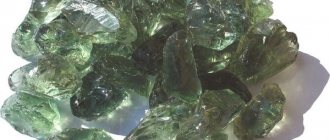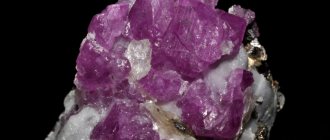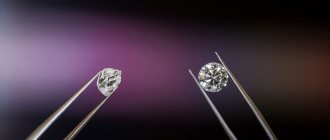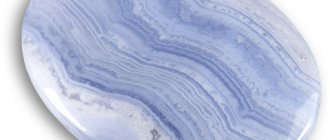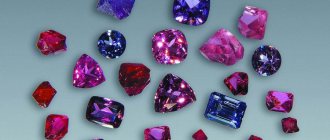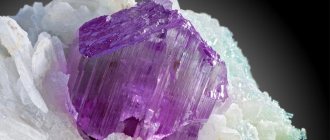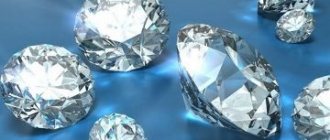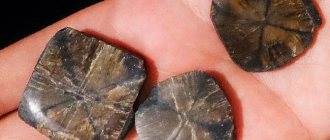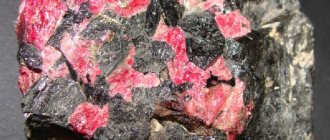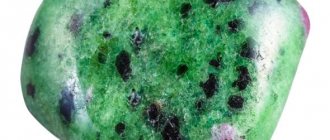| Category | Rocks |
| Title in English | Obsidian |
| Formula | SiO2 |
| Group | Acid rock group |
| Color | Black, Brown, Transparent |
| Stroke color | White |
| Shine | Glass |
| Transparency | Opaque, Translucent |
| singonia | Amorphous |
| Hardness | 5 — 6 |
| Cleavage | Absent |
| Density, g/cm³ | 2,5 — 2,6 |
| Kink | Large-shelled |
| origin of name | The name obsidian has two origins. According to the first, mirrors were made from this igneous rock, so the ancient Greek word οβσις was used for the name. It is translated into Russian as a spectacle. According to another version, the stone was named after the Roman Obsidia, who once brought the mineral from Ethiopia to Rome for the first time. The full name was Obsidianus lapis, which is translated from Latin as Obsidia stone. |
The mineral obsidian has been known to mankind for about 9,000 years. The mineral received its name in honor of the Roman Obsidius. Obsidian is found in lava that hardens after volcanic eruptions. And already in the Paleolithic, people could easily make a knife, ax or spear based on this stone. As stone processing technologies developed, obsidian became more and more famous. At the end of the 19th century, its popularity increased significantly due to its use in Faberge products. Now obsidian is widely used in jewelry and as an ornamental stone.
Obsidian deposits
The largest obsidian deposits are located in Ecuador, Mexico, Indonesia, Japan, Ethiopia, Peru, Germany, Turkey, Armenia, Iceland and the USA, wherever there are zones of volcanic activity in ancient or modern times. In Russia, obsidian deposits were found in Kamchatka, the Caucasus and Siberia. Iridescent obsidians are found in Nevada and the Hawaiian Islands.
Receipt
Destruction
Obsidian can be mined with either a diamond or netherite pickaxe.
| Block | Obsidian | |
| Strength | 50 | |
| Time of destruction | ||
| Default | 75 | |
The “Efficiency” enchantment on the pickaxe speeds up the obsidian mining process by 23%. Below are the mining times for each enchantment level.
| Tool | Enchantment | Mining time |
| Diamond pickaxe | No | 9.4 s |
| Efficiency I | 7.25 s | |
| Efficiency II | 5.55 s | |
| Efficiency III | 4.3 s | |
| Efficiency IV | 3.3 s | |
| Efficiency V | 2.5 s |
Natural generation
Obsidian can be found in the chests of village forges, bastion ruins, and destroyed Nether portals.
Obsidian is generated as part of obsidian pillars, End ships, underwater canyons and destroyed Nether portals.
Can be generated randomly if water flows onto the lava lake in the cave.
Barter
A Piglin can exchange a gold bar for 1 block of obsidian.
History of obsidian
— Advertising —
For the first time, obsidian was brought from Ethiopia to Europe by a Roman named Obsidius, which was the reason for the appearance of this name for the stone. Obsidian was known by different names among different peoples. For example, in Transcaucasia, as “a fragment of Satan’s claws”, in America as “tears of the Apaches”. The Greek term "obsis" translates as "spectacle", and may also have had an influence on the formation of the mineral, as in ancient times it was used to make mirrors.
During the Stone Age, primitive people used obsidian in the manufacture of knives, arrowheads, and scrapers. They were sharper than metal ones and therefore popular. In Egypt, incense was stored in obsidian vessels to preserve its qualities. Writing utensils were also made from the stone, as it was believed that obsidian had a beneficial effect on the thought process of its owner. Residents of the Caucasus and India endowed obsidian with magical properties and used it as a ritual stone.
Obsidian gained popularity in jewelry at the end of the 19th century, when Carl Faberge began using it in this capacity.
From stone ax to souvenir
It will take a long time to describe the joint path of man and volcanic glass. Therefore, we will quickly go over the beginning of the friendship between man and stone.
Our time machine is at your service. Route: our days - Paleolithic, Stone Age - our days. Stops on request. Let's go back to the dawn of humanity, 2.5 million years ago. Then appearance did not matter, and hominids (our ancient ancestors) tried not to live, but to survive.
It was hard to survive; there were no shops or jobs with a stable salary. We had to exist according to the principle “what goes around comes around.”
To eat a fried steak, you had to first get it (when it grunted or growled).
Metal products appeared 8000 BC, but I wanted to eat long before that.
Our clever ancestors came up with stone tools. Obsidian stone was ideal for them. It is easy to make piercing and cutting tools from it to kill a mammoth or deer. Because throwing yourself bare-handed at a cave bear is dangerous to your health. Another thing is the spear.
Our ancestors highly valued the properties of obsidian. So much so that they were not content with local stones, but organized expeditions to the places where obsidian stones were mined.
For history buffs: many obsidian spearheads were discovered in the Baksan region of the Kabardino-Balkarian Republic. And for the stone for the tips, the Neanderthals went as far as 250 kilometers, to the Zayukinsky spring.
Later they began to make stones... no, not jewelry. Ritual items for priests who enjoyed enormous influence in the tribe. The razor-sharp edges of obsidian knives were perfect for ripping open the flesh of unfortunate victims.
The Aztec and Mayan tribes, notorious for mass sacrifice, cut out the hearts of living people with ritual obsidian knives.
We recommend: The meaning and properties of QUARTZ DRUZ
The priest or shaman decided who to sacrifice.
While men were running after mammoths, women were in secondary roles. But hunting is an unreliable business. While the men were hunting, the woman spent the whole day collecting roots, herbs, and berries. And she tried to cultivate them. Thus began the era of agriculture, and with it matriarchy. Women took power. Well, as the saying goes, “he who feeds the food, also ... calls the tune.”
- It's time for decorations. Including obsidian jewelry.
- Glyptics is the first jewelry craft of man.
- It is in the nature of a woman to decorate herself, whether she is a Neanderthal or a businesswoman of the 21st century.
- So our beads, pendants, pendants originated a very long time ago.
- And they fell in love not only with women, but also with men.
Historical fact: Mark Antony (the same lover of Cleopatra) was a prominent politician and military leader. I wanted to have the gem of Senator Nonnius to the point of madness. The senator valued the gem and did not want to part with his favorite piece of jewelry. It was within Anthony’s power to throw an unyielding senator into lifelong exile from Rome, which was done. Nonnius's career collapsed, but his beloved gem remained with him.
This is how highly valued jewelry was in the Hellenistic era.
Further - more, jewelry has become an indicator of success and wealth. So it was, so it is. Most likely it will.
And volcanic glass, which helped people survive at the dawn of mankind, now works peacefully in production and in jewelry.
This is the importance of obsidian in human development.
Physico-chemical characteristics of obsidian
Obsidian is a glassy rock of volcanic origin, which is why it is sometimes called volcanic glass.
Its formation occurs during the rapid cooling of lava, which spills onto the ground during a volcanic eruption. Obsidian is an amorphous stone. By chemical nature it is silicon oxide with admixtures of magnesium and iron oxides. — Advertising —
Obsidian is colored in shades of gray, brown, red and black. It has an amorphous system and a conchoidal fracture. The hardness of the stone is 5-6 on the Mohs scale. Specific gravity 2.3 g/cm3.
Physical and chemical properties
Obsidian is a stone that is mined from volcanic rock. Its other name is volcanic glass. Due to its origin, the mineral has low wear resistance. It is fragile and has a foamy structure. The composition is acidic, similar to granite.
Obsidian contains a high content of silicic acid and alumina. Otherwise, the mineral is similar to granite. It does not contain water, is polished and has a vitreous luster. Obsidian belongs to the newest rocks with a unique amorphous structure.
Due to the viscous nature of lava, the stone is often found in association with rhyolite and liparitic porphyry.
| Formula | SiO2 oxide with acidic content |
| Color | Black, brown, red, transparent |
| Shine | Glass |
| Transparency | Transparent and opaque |
| Hardness | 5-6 |
| Cleavage | Absent |
| Kink | Large-shelled |
| Density | 2.5-2.6 g/cm³ |
| Radioactivity | No |
| Melting temperature | 1300-1500 °C |
In terms of physical properties, obsidian can be compared to glass. When split, it forms many fragments with sharp edges. Because of this, the mineral played a big role in the history of mankind - in the places where it was formed, people could make weapons and jewelry.
Types of obsidian
There are several subspecies of obsidian depending on color:
- “Peanut” or “snowy”, painted in gray-white color, and “snowflakes” seem to be scattered across its surface.
- Rainbow is distinguished by unique color tints that resemble oil drops. The most valuable and expensive subspecies.
- Red obsidian.
- Green obsidian.
- Blue-blue obsidian.
What is volcanic glass?
There are several types of volcanic glass:
- Resin stone (pechstein) , it also has options - diabase, liparite, phonolite stones. It can be black, brown (very light or dark), green, red-brown. The shine is greasy, resinous.
- Snow obsidian . Black in color with white spots of various shapes. The most interesting specimens are covered with snowflake-like spots. It is sometimes called "peanut obsidian".
- Rainbow obsidian . It is rare and therefore valuable. When cut, it often resembles a rainbow film of gasoline. Painted in blue, reddish, greenish colors and their shades.
We recommend: ALPANIT - Swarovski's crystal fairy tale
The stone looks very presentable. Impenetrable depth, shine, bright color attracts the eye.
The magical properties of obsidian
It is believed that obsidian contains the power of the Sun, Saturn and Uranus, and people have turned to its magical abilities since ancient times.
So, special balls for fortune tellers were made from it. As a protective amulet, obsidian keeps the owner from committing bad deeds and helps fight shortcomings. It protects from the evil eye and negative energy. The mineral gives composure, the ability to concentrate and focus on the most important, makes thoughts precise and sharp. For this reason, writing instruments are often made from it. In the Caucasus, obsidian was considered the patron saint of children, capable of protecting them from harm, the evil eye and damage.
Compatibility with other stones and names
Combinations of rocks and minerals are a controversial section of magic, lithotherapy, and astrology. As criteria, you can choose the subordination of one element, the control of the planets. If the alignment is incorrect, negative vibrations are possible.
Obsidian is a stone belonging to the element of Earth.
Its combinations with agate, onyx, jasper, amber, and malachite are favorable. Other “buddies” of volcanic rock: jade, turquoise, emerald, jet, aventurine. Lava glass feels good next to Fire minerals - garnet, hematite, topaz, tiger's eye, carnelian, red agate, diamond. Great combination with rock crystal. The stones enhance each other's energy. Not compatible with ruby.
Earrings with obsidian and rock crystal.
Obsidian is more suitable for Tatyans, Darias, Natalias, and Maxims. The stone helps people bearing these names choose the right path and avoid unwanted deviations from it. Volcanic glass also suits the name Ilya. Obsidian gives a man with this name energy and strength to withstand adversity and adapt to changes in life.
Medicinal properties of obsidian
Traditional medicine uses obsidian to treat colds that appear during hypothermia.
It is also believed to have a positive effect on the gastrointestinal tract. Obsidian beads and rosaries normalize blood pressure. In general, obsidian is useful as a preventative. But wearing it all the time is not recommended.
Branches of application of obsidian
Obsidian fragments have sharp cutting edges, which is why ancient people began to use the mineral.
Scrapers, knives, spears, axes, arrowheads - all this was made on the basis of this mineral. Obsidian artifacts discovered in Mesopotamia date back about 9,000 years. Later, various jewelry and amulets, household items and ritual figurines began to be made from obsidian. The Aztecs and Ethiopians learned to make mirrors from it. Obsidian knives became objects of rituals. And, despite the fact that people learned to make such iron products, obsidian did not lose its leadership position.
Obsidian began to be widely used as a jewelry and ornamental stone in the 19th century. Carl Faberge was the first to draw attention to the interesting properties of the stone and its attractive appearance. Today, obsidian is in demand among other semi-precious stones for making watches, writing sets, fountains, animal figurines, beads, key rings, and rosaries.
The mineral has also found application in industry as an intumescent filler for lightweight concrete.
Where is it used
The first people found volcanic glass near their sites, because in ancient times eruptions were frequent. Together with flint, obsidian became one of the first natural materials that was processed to produce simple tools and weapons (knives, arrows, spears). Women used pieces of shiny polished stone as a mirror.
Processed obsidian was used in surgery and was highly valued in the manufacture of jewelry and art objects. During the time of the masters of the Faberge jewelry house, the mineral was “rediscovered” for the high society of Europe. The “obsidian boom” began - increased interest in jewelry made from this stone. Subsequently, the windy fashion changed direction.
Obsidian is still used as an ornamental material. Jewelry is made from it. Bracelets, pendants, inserts in rings and earrings, and beads look great. The interior is decorated with animal figures and pyramids made of volcanic glass. Rosary beads and obsidian chess pieces look impressive.
Volcanic glass chess.
Mineral cost
Ornamental stones are inexpensive because they are not rare. The price for 1 kg of obsidian is 50 rubles. The rarest varieties, of which there are few, are more expensive. For example, the price for 1 g of rainbow stone is from 500 to 800 rubles.
Green, golden, ruby volcanic glass is close to precious stones in value. In many ways, the price depends on the deposit and the volume of processing that was required after mining the rock.
How to distinguish real obsidian from a fake
Counterfeits of natural obsidian are often made from painted glass; they can be distinguished by the following characteristics:
- Natural stone has a rich matte color and pronounced shine.
- A piece of natural origin stays cold in your hands for a long time, unlike glass that heats up quickly.
- Natural stones never have a uniform structure and contain inclusions.
- When immersed in water, imitations lose their shine and color saturation.
How to care for obsidian
Since obsidian is a fairly fragile mineral, jewelry made from it is stored in separate soft cases.
They should not be left in the bright sun or in water for a long time. Obsidian is also protected from temperature changes and mechanical damage. The use of chemicals is not recommended for cleaning products. It is better to use a mild soap solution or cold running water, then wipe the product with a soft cloth.
Achievements
Main article: Achievement system
| Icon | Achievement | Description | Task | Availability | Xbox Points | Trophy type (PS) | |||
| Xbox | PS | Bedrock | Nintendo | ||||||
| Into The Nether | Build a portal from obsidian - 4 blocks wide and 5 blocks high, and set it on fire with flint to get to the Nether. | Light the portal to the Nether. | Yes | PS3 | Yes | Yes | 40G | Silver | |
| PS4, Vita | Bronze | ||||||||
| Enchanter | Use 1 book, 4 obsidians and 2 diamonds to assemble an enchanting table. | Take the enchanting table from the crafting grid. | Yes | PS3 | Yes | Yes | 20G | Silver | |
| PS4, Vita | Bronze | ||||||||
Main article: Achievement system (Java Edition)
| Icon | Achievement | Description | Ancestor | Task (if different) | Identifier |
| Two elements | Get Obsidian | Hot stuff | Receive an obsidian . | minecraft:story/form_obsidian |
Obsidian and zodiac sign
Obsidian is the patron saint of representatives of the Capricorn sign, whose life it will definitely change for the better and help to be brave and decisive. Obsidian also takes Leo and Sagittarius under its protection. Jewelry made from it can be worn by Scorpios, Aquarius and Gemini. Only for Cancer and Virgo the stone is not recommended, as it endows them with irritability and vindictiveness.
Interesting facts about obsidian:
- Obsidian is considered a talisman for magicians and scientists. It is believed that beads made from it develop clairvoyance, protect against negative energy, and protect from evil spirits.
- There is a widespread legend in the Caucasus about how Satan once got angry and then pieces of his nails began to fly out to the ground along with the lava. That is why the stone received the unusual popular name “Satan’s nail.”
- According to American legend, the Apache camp was once attacked by colonists. In order not to surrender to the conquerors, the local residents decided to throw themselves from the cliff into the mouth of the volcano. The women mourned their husbands for three nights, and their tears became beautiful black stones - obsidians, “tears of the Apaches.”

